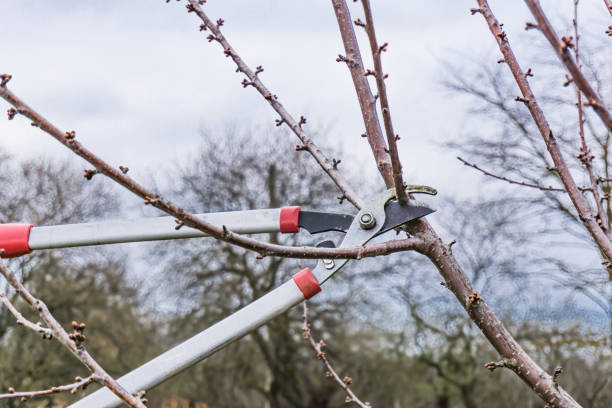Written by and published on https://www.familyhandyman.com/
Winter is hard on plants. Heavy snow, freezing ice storms, and violent wind all have the potential to damage trees. Cold weather damage to trees is sometimes obvious with broken limbs or it may be slow and insidious, not showing up until spring. The severity of the injury will dictate when to prune after winter damage. Learn the when and how to prune winter-damaged trees to reinvigorate and restore them to health. Provide good care and ensure the health of the tree/shrub is at its peak and most damage will not cause significant long-term problems. It is a good idea to prune young trees to create a strong scaffold and prevent top-heavy plants and unbalanced limbs. This helps prevent future injury and build a sturdy frame.
Table of Contents
Here’s Why You Should Be Scared of Your Trees After a Winter Storm
The winter can do quite a bit of damage to those trees…
Dealing with a Polar Vortex can sure be an anxiety-ridden time for a homeowner. As if preventing freezing pipes and exploding toilets wasn’t enough, carefully checking out the trees in your yard should also be on the list. Why? Frost cracks.
According to experts at the Monster Tree Service, trees that have been under extreme winter temperatures and storms can experience trauma that will affect the trunks of the trees. This happens when a tree is exposed to fluctuating temperatures. After the Polar Vortex in January 2019, Minneapolis’ weather jumped almost 50 degrees in just one week, from -28 degrees to 20 degrees Fahrenheit.
Arborists speculate where frost cracks come from, but Monster Tree Service finds frost cracks to occur due to temperature fluctuations. This causes the trunk to expand and contract rapidly, leading to vertical splits on the bark and deeper (similar to a soda expanding and exploding when frozen).
“Often you can hear them occur, they sound very loud, almost like a rifle bang,” said Adam Barker, Arborist Sales Manager at Monster Tree Service. “But if it’s been cold conditions and it’s a thin bark tree and you see a new crack in the tree, you can probably narrow down the different [signs] to see if it happens to be a frost crack. If you can see fresh wood fibers below the surface and it’s a visible crack, and it’s been very cold lately, then there’s a good chance that a frost crack has occurred.”
Assessing your landscape is vital after any extreme weather or storm. Harm to the trees could be potential hazards for the rest of your landscape. It could affect any close wiring and cause power outages, create terrible property damage, or even cause serious injuries.
In order to properly asses your landscape, here are three tips from the experts at Monster Tree Service.
If you shake it, you break it
If a tree has damage to it, or is starting to lean, resist the urge to shake it (especially if there’s snow that’s weighing it down). Shaking it could actually cause damage to occur, which in return could cause injury for yourself.
However, it’s important to evaluate where your trees are before any snow loading or ice loading occurs from the storm.
“That extra weight on the trees could cause uprooting and stem failure, so it’s really important to look out for trees that are over targets, so a target might be a home, could be a driveway, could be a car, could be a public right of way like a sidewalk or a road,” said Barker.
Remove any broken branches
If you see broken branches around the perimeter, remove them immediately. These could cause a hazard to you and your property. If you see broken limbs hanging from the tree, it may be wise to call in for help.
“Broken limbs that may break in storm conditions and might become hung up or lodged in the tree that could come down at any point,” said Barker. “The last thing you want to do as a homeowner is to climb a ladder in snow or icy conditions, or attempt to pull large limbs out either with rope or pulls or a combination of the two, and find yourself beneath unhealthy wood timber or sharp sticks.”
If you see worse damage, call an expert
Noticing any of those frost cracks, or any other significant damage? Call a professional! It’s important to stay safe. Plus, professionals have an eye for assessing damage that you may not even know of.
“Uprooted trees is a common occurrence under storm conditions,” said Barker. “So, if see cracks in the soil that were not there before beneath the tree, it’s an indication that the tree is starting to heave or lean, and that’s something to be wary of. Those trees need to be cabled down or guide roped down to our ability, or removed, depending on how bad the situation is.”
Original post here https://www.familyhandyman.com/article/cracks-in-trees/.

